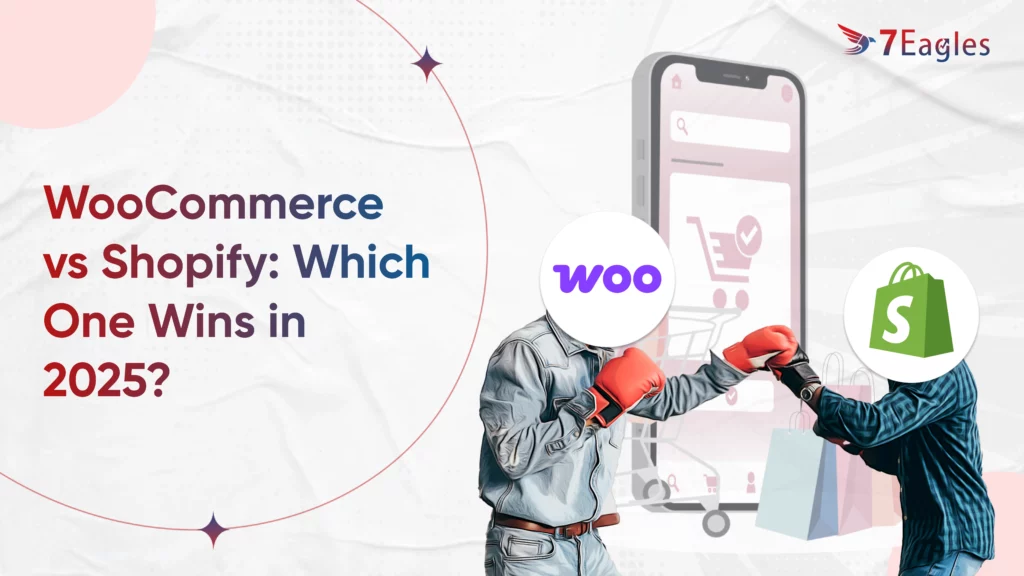WooCommerce vs Shopify in 2025: Which One Wins for Developers?
If you're a developer diving into eCommerce in 2025, chances are you've crossed paths with WooCommerce and Shopify. These two giants power millions of online stores worldwide, but when it comes to flexibility, customization, and developer experience, the question remains:
Which platform is better for developers — WooCommerce or Shopify?
In this blog, we’ll break down WooCommerce and Shopify from a developer’s perspective, comparing their customization potential, ecosystem, APIs, tech stack, and overall control. Whether you’re building for clients, creating custom plugins, or launching your own SaaS, this guide will help you choose the right platform.
🔍 Overview of Both Platforms
🧩 WooCommerce
• Open-source plugin for WordPress.
• Built with PHP, MySQL, HTML/CSS, JavaScript.
• Self-hosted: Complete control over code, database, and infrastructure.
• Ideal for custom development, integrations, and full-stack solutions.
🛒 Shopify
• Hosted SaaS platform
• Built with Ruby on Rails (backend) and Liquid templating engine (frontend)
• Developer tools include Shopify CLI, Hydrogen (React-based storefronts), and Storefront API
• Ideal for quickly launching stores, especially with fewer custom backend needs
💡 Developer Experience (DX)
🛠 WooCommerce
Pros:
• 100% open-source — you can modify anything
• Leverages familiar WordPress architecture (hooks, filters, custom post types)
• Thousands of plugins and themes that can be extended or overridden
• Easy to build custom plugins or REST API integrations
• Supports headless development (e.g., with Next.js, Gatsby)
Cons:
• Requires more setup and maintenance (hosting, updates, security)
• Inconsistent coding patterns between plugins
• PHP isn't as trendy with newer developers
🔧 Customization & Extensibility
WooCommerce
You can:
• Build your own plugins or child themes
• Override Woo templates directly
• Add custom fields, post types, or admin settings easily
• Access raw database queries
• Modify checkout flow, product types, and more
Woo is built for total control. If you can dream it, you can build it.
Shopify
Customization is limited to:
• Themes via Liquid
• Storefront API or Hydrogen (React-based) for headless builds
• Apps (hosted externally) using Node.js, Ruby, or other stacks
• Functions (Shopify’s serverless platform) — still limited compared to full access
Shopify has improved drastically in 2025 with Shopify Functions 2.0 and more extensibility, but core logic is still off-limits.
Verdict: WooCommerce is unbeatable for raw customization.
🌐 API & Headless Capabilities
WooCommerce
REST API support is mature and flexible
• Can extend the API easily via custom endpoints
• Ideal for JAMstack and headless builds (Next.js, Nuxt, etc)
• Supports GraphQL via third-party plugins
Shopify
• Storefront API (GraphQL) is modern and robust
• Admin API (REST and GraphQL) for backend operations
• Hydrogen (Shopify's React-based headless framework) is tightly integrated
• Native support for edge functions and Hydrogen 2.0 in 2025 improves performance
Verdict: Shopify wins in headless tools, but WooCommerce gives more backend freedom.
💼 App & Plugin Development
WooCommerce
• Build custom plugins that run inside WordPress
• Monetize via your own channels or the WordPress.org repository
• No restrictions on features, payment gateways, or licensing
Shopify
• Apps are hosted externally and integrate via API
• App Store is a huge opportunity — but you must follow Shopify’s review rules
• Revenue share: Shopify takes 20% after $1 million in annual earnings
• Shopify’s dev tools make it easy to scaffold apps quickly
Verdict: WooCommerce wins for freedom, but Shopify wins for monetization reach.
💰 Hosting, DevOps & Maintenance
WooCommerce
• Self-hosted = you handle server setup, backups, and scaling
• Use providers like Kinston, WP Engine, or Digital Ocean
• Requires ongoing maintenance and monitoring
Shopify
• Fully managed = zero hosting or scaling headaches
• SSL, CDN, backups, and performance handled for you
• Updates and patches done automatically
Verdict: Shopify wins hands down for DevOps ease.
📈 Performance & Scalability
WooCommerce
• Depends on hosting and optimization
• Heavy plugins or large stores can affect performance
• Advanced caching and optimization needed for high-traffic stores
Shopify
• Lightning-fast out of the box with global CDN
• Built to scale — from startups to enterprise stores
• Hydrogen’s edge rendering brings fast performance for headless builds
Verdict: Shopify scales faster, but WooCommerce can match with good hosting.
🧠 Learning Curve
•WooCommerce
Easier for WordPress/PHP developers. More flexible, but more complex as the project scales.
•Shopify
Easier for frontend devs familiar with JS, React, and APIs. Liquid has a steeper learning curve initially.
Verdict: Depends on your background — PHP devs will love WooCommerce, JS devs may prefer Shopify.
🏁 Final Verdict: Who Wins in 2025?
Category | Winner |
Developer Experience | Tie |
Customization | WooCommerce |
Headless/API | Shopify |
Plugin/App Dev | WooCommerce (freedom) |
Hosting & DevOps | Shopify |
Performance | Shopify |
Learning Curve | Depends on background |
|
|
🏆 Overall Developer Winner in 2025: It’s a Tie — But Choose Based on the Project
•Choose WooCommerce if:
• You need deep backend control or fully custom workflows
• You’re building complex, niche eCommerce products
• You prefer open-source and own your infrastructure
•Choose Shopify if:
• You want speed, simplicity, and scalability out of the box
• You’re building high-performing headless storefronts
• You’re developing apps for a huge merchant ecosystem
Conclusion
In 2025, both WooCommerce and Shopify are excellent platforms — but they shine in different areas for developers.
WooCommerce gives you freedom.
Shopify gives you convenience.
As a developer, your choice will come down to project requirements, your preferred tech stack, and how much control you need. Whether you’re hacking away on PHP hooks or deploying Hydrogen storefronts to the edge — you’ve got powerful tools at your disposal.
What’s your pick for 2025? Woo or Shopify? Let us know in the comments 👇
